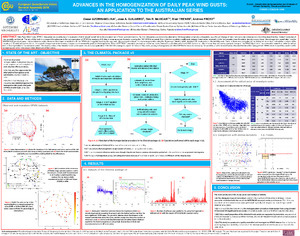Por favor, use este identificador para citar o enlazar este ítem:
http://hdl.handle.net/20.500.11765/11953
Advances in the homogenization of daily peak wind gusts: an application to the Australian series
Registro completo de metadatos
| Campo DC | Valor | Lengua/Idioma |
|---|---|---|
| dc.contributor.author | Azorín Molina, César | es_ES |
| dc.contributor.author | Guijarro Pastor, José Antonio | es_ES |
| dc.contributor.author | McVicar, Tim R. | es_ES |
| dc.contributor.author | Trewin, Blair C. | es_ES |
| dc.contributor.author | Frost, Andrew J. | es_ES |
| dc.date.accessioned | 2020-05-28T13:16:31Z | - |
| dc.date.available | 2020-05-28T13:16:31Z | - |
| dc.date.issued | 2018 | - |
| dc.identifier.citation | EGU General Assembly (2018) | es_ES |
| dc.identifier.uri | http://hdl.handle.net/20.500.11765/11953 | - |
| dc.description | Póster presentado en: EGU General Assembly 2018 celebrada del 8 al 13 de abril en Viena, Austria. | es_ES |
| dc.description.abstract | Daily Peak Wind Gusts (DPWG) time-series are valuable data for evaluation of wind related hazard risk to the population and different economic sectors. Yet wind time-series are prone to be affected by inhomogeneities temporally and spatially (e.g. through change of instruments at a site compared to surrounding sites) that may mislead the studies of their variability and trends. The aim of this work is to present the advances in the homogenization of DPWG by analyzing 548 sites time-series across Australia covering the 1941-2016 time period. Due to the low correlation coefficients between these series, especially in the first decades when the station density is much lower, the average wind speed data from the NCEP/NCAR reanalysis were tried as reference series. However, their lower correlations with the DPWG data suggests avoiding this approach. We proposed a robust monthly homogenization using the R package Climatol, which detected 353 break-points at the monthly scale. Some of them were supported by the history of the stations, but detailed analysis of the metadata of 35 selected stations did not find a good correspondence since many changes do not necessarily produce inhomogeneities. When NCEP/NCAR reanalysis are used as references, more break-points are detected around 2003, but it is not clear whether they are due to a general change of the DPWG algorithm in the observation network or rather an artifact due to inhomogeneities in the reanalysis series. The monthly dates of the detected break-points were used in a new application of the Climatol package to adjust the series at daily basis, yielding a homogenized and filled DPWG database for assessing the variability of extreme wind events. Resultant trends of the homogenized DPWG series showed the benefits of the homogenization in the form a much lower dispersion of their values. | es_ES |
| dc.description.sponsorship | This work has been also supported by the Project “Detection and attribution of changes in extreme wind gusts ove rland” (2017-03780) funded by the Swedish Research Council, and the MULTITEST (Multiple verification of automatic software homogenizing monthly temperatura and precipitation series; CGL2014-52901-P) Project ,funded b ythe Spanish Ministry of Economy and Competitivity. | es_ES |
| dc.language.iso | eng | es_ES |
| dc.subject | Daily Peak Wind Gusts | es_ES |
| dc.subject | Hazard | es_ES |
| dc.subject | Wind speed | es_ES |
| dc.title | Advances in the homogenization of daily peak wind gusts: an application to the Australian series | es_ES |
| dc.type | info:eu-repo/semantics/conferenceObject | es_ES |
| dc.relation.publisherversion | https://dx.doi.org/10.13140/RG.2.2.31428.12168 | es_ES |
| dc.rights.accessRights | info:eu-repo/semantics/openAccess | es_ES |
| Colecciones: | EGU General Assembly | |
Ficheros en este ítem:
| Fichero | Descripción | Tamaño | Formato | ||
|---|---|---|---|---|---|
| Azorin_Molina_et_al__... | 1,84 MB | Adobe PDF |  Visualizar/Abrir |
Los ítems de Arcimis están protegidos por una Licencia Creative Commons, salvo que se indique lo contrario.





